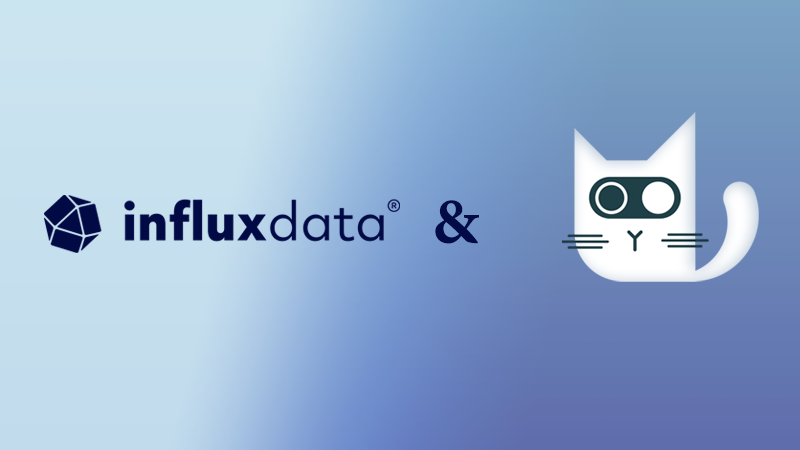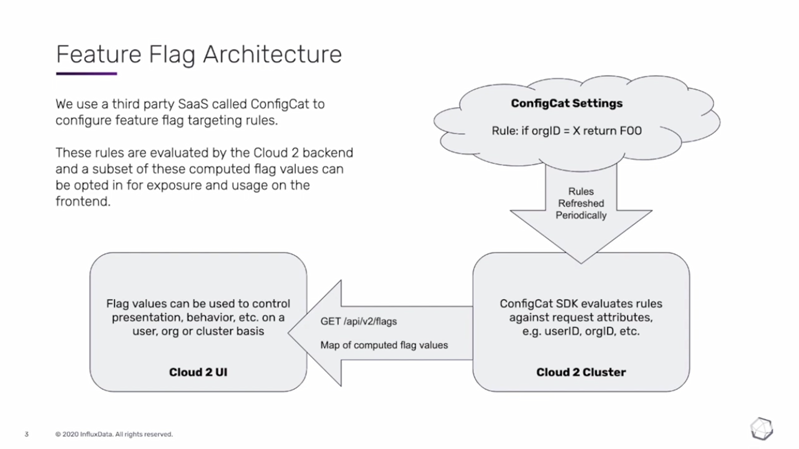InfluxDB's Success Story with ConfigCat
In the ever-evolving world of software development, the ability to create personalized and dynamic user experiences is paramount. This article explores how InfluxDB, a prominent time-series database solution, leveraged ConfigCat's feature flags to enhance their Cloud 2 user testing processes. The insights shared in this article are based on a video presentation by Gavin Cabbage from InfluxDB.

Gavin's Demo: A Glimpse into Cloud 2 User Testing
Gavin's presentation showcased how InfluxDB harnessed the power of ConfigCat feature flags for user testing within their Cloud 2 environment. The primary goal was to illustrate a testing flow, emphasizing that there are various other ways to do it.
Let's jump into the demonstration, but first, a few words need to be mentioned about these useful tools. Feature flags, also referred to as feature toggles, serve as a valuable instrument in software development, providing developers with the capability to activate or deactivate specific features in a live environment. This dynamic functionality allows for controlled adjustments to the application's behavior without the need for code changes, offering flexibility in managing feature releases and testing different configurations.
In this specific pattern presented, InfluxDB had particular users in mind and aimed to provide them with different prototypes for testing. The demo highlighted the ease with which ConfigCat could be integrated into their existing infrastructure and workflow to perform dynamic and targeted user testing. They could configure rules within the ConfigCat console, making it possible to effectively personalize the user experience. This flexibility allowed InfluxDB to gather invaluable user feedback and preferences insights.
Here you can see the feature flag architecture built out for Cloud 2:

Key Takeaways from the Presentation
Dynamic User Testing
In the video, InfluxDB demonstrated how they configured rules within the ConfigCat console to personalize the user experience effectively. For instance, they could change the language in messages, offering different versions of a message to different user segments: one user could be met with the slightly mean "No dashboards found dummy!" message, while for others "I am so sorry! We couldn't find your dashboards" appeared.
Effortless Integration
InfluxDB showcased how ConfigCat seamlessly integrates into the development process. Developers can easily incorporate feature flags into their code, as ConfigCat generates the necessary code based on the configuration. This integration not only streamlines operations but also maintains type safety in the backend, reducing the chances of errors.
Centralized Control
ConfigCat acts as a central hub for managing feature flags. In the presentation, InfluxDB demonstrated how they could configure flags, set default values, and control exposure to the front end — all from a single location. This centralized control simplifies flag management and reduces complexity, making it easier for teams to collaborate.
Real-Time Configurations
As demonstrated, changes to the application's behavior can be made without requiring code deployments. This real-time flexibility allows teams to respond promptly to user feedback and evolving requirements. For example, InfluxDB showed how they could instantly change the content of a message for different users.
Front-End Control
In the demo, InfluxDB illustrated that some feature flags can also be exposed to the front end. This feature provides developers with control over the presentation and behavior of the application. They can use feature flags for backend functionality and customizing the user experience, which can be particularly useful in A/B testing and user-centric feature rollouts.
Scalability
The video showcased how ConfigCat's feature flags are scalable, making them suitable for different phases of deployment. In this case, InfluxDB simulated deployment to a local environment, but the flexibility to apply the same principles to various stages of deployment — such as staging and production — makes ConfigCat a versatile tool for both small-scale testing and large-scale implementations.
The Power of User-Centricity
InfluxDB's success with ConfigCat's feature flags underscores the importance of prioritizing the user in software development. By tailoring experiences, gathering feedback, and responding swiftly to user preferences, they elevated their user-centric approach.
ConfigCat's platform offered the tools needed to make this transition seamless and effective. It provided InfluxDB with the ability to experiment, iterate, and refine user experiences continuously. This user-centric perspective not only enhances the user journey but also ensures that software aligns more closely with user needs and expectations.
Wrapping it up
ConfigCat's feature flags are a valuable asset for any organization seeking to improve user experiences and streamline user testing. InfluxDB's successful journey demonstrates that with the right tools and a user-centric mindset, software development can evolve to meet the ever-changing demands of the modern tech landscape. As technology continues to evolve, ConfigCat's feature flags are sure to remain a cornerstone of success for those who prioritize aligning software more closely with user needs and preferences. Deploy any time, release when confident.
ConfigCat supports simple feature toggles, user segmentation, and A/B testing and has a generous free tier for low-volume use cases or those just starting out.
If you want to stay up-to-date with the mischievous antics of the cat with feature flags, follow ConfigCat on X, Facebook, LinkedIn, and GitHub.
